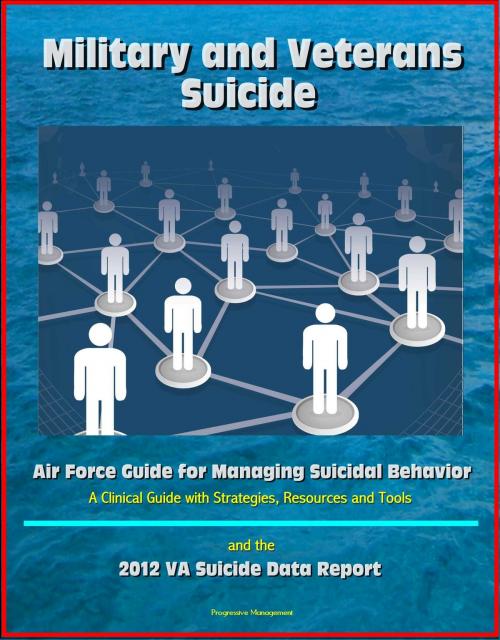Military and Veterans Suicide: Air Force Guide for Managing Suicidal Behavior, A Clinical Guide with Strategies, Resources and Tools, and the 2012 VA Suicide Data Report
Nonfiction, Health & Well Being, Medical, Specialties, Psychiatry, Ailments & Diseases, Mental Health| Author: | Progressive Management | ISBN: | 9781301768875 |
| Publisher: | Progressive Management | Publication: | February 6, 2013 |
| Imprint: | Smashwords Edition | Language: | English |
| Author: | Progressive Management |
| ISBN: | 9781301768875 |
| Publisher: | Progressive Management |
| Publication: | February 6, 2013 |
| Imprint: | Smashwords Edition |
| Language: | English |
This compendium on the problem of military and veteran suicides includes two documents: the Air Force Guide for Managing Suicidal Behavior and the Suicide Data Report of the Department of Veterans Affairs.
Air Force Guide for Managing Suicidal Behavior - Strategies, Resources and Tools - This document is a clinical guide. "We developed this guide in an effort to help to Air Force mental health staff navigate one of the most difficult and complex aspects of clinical practice: suicidal behavior. In each clinical encounter, we potentially face the most serious of consequences for our patients as well as potential legal threats to the Air Force and ourselves, yet mental health professionals typically receive minimal formal training in managing suicide and generally feel insufficiently prepared to handle it. This guide pulls together state-of-the-art knowledge and best practices for the clinical management of suicidal behavior to make providing this care easier for mental health providers, nurses, technicians and clinic staff. The guide was structured around a set of 18 recommendations, organized within eight topical chapter headings. You will find these recommendations listed. Note that the scope of the recommendations is the management of suicidal behavior, not treatment per se (i.e., medications and dosages, how to do cognitive behavioral therapy for suicide, etc.). Following each recommendation, we present further discussion on strategies, tools, and resources for meeting that recommendation." Contents: Preface * Introduction * Suicide Management Recommendations * Summary of Empirical Findings on Clinical Management of Suicide * Common Errors in the Management of Suicidality * Assessment of Suicide Risk * A Decision-Making Framework * Outpatient Management Strategies * Documentation Strategies * Coordinating with Inpatient Care * Clinic Support and Peer Consultation * Ensuring Continuity of Care * Links with the Community * When a Suicide Occurs * Resources and Recommended Readings * References
Suicide Data Report, 2012 - In 2007, the Department of Veterans Affairs began an intensive effort to reduce suicide among Veterans. This effort had its roots in the Mental Health staffing expansion and the Joshua Omvig Bill, and it included both attention to Veterans in crisis as well as those determined to be at high risk for suicide. The effort also included the development of data systems to increase understanding of suicide among Veterans and inform both the VA and other suicide prevention programs. Information on the characteristics and outcomes of Veterans at risk for suicide is critical to the development of improved suicide prevention programs. Contents: Introduction * State Mortality Data Project * Project Cost * Project Status * Reliability and Validity of Veteran Identifiers * Limitations of Existing Data * Suicide among Veterans - As Reported on Death Certificates * Veteran Status and Demographic Characteristics among Suicide Decedents * Suicide Prevention Applications Network/Suicide Behavior Reports * Prevalence and Characteristics of Non-Fatal Suicide Events * Veterans Crisis Line * Prevalence and Characteristics of Calls to the Veterans Crisis Line * Conclusion * Appendix A: Veteran Status on Death Certificate by State and Year * Appendix B: Timeframe for Updated to Mortality Data by State * Appendix C: Non-Fatal Event Rates by Age Group and Gender (per 100,000 Users) * Appendix D: 12-Month Re-Event Prevalence by Age Group and Gender * Reference List
This compendium on the problem of military and veteran suicides includes two documents: the Air Force Guide for Managing Suicidal Behavior and the Suicide Data Report of the Department of Veterans Affairs.
Air Force Guide for Managing Suicidal Behavior - Strategies, Resources and Tools - This document is a clinical guide. "We developed this guide in an effort to help to Air Force mental health staff navigate one of the most difficult and complex aspects of clinical practice: suicidal behavior. In each clinical encounter, we potentially face the most serious of consequences for our patients as well as potential legal threats to the Air Force and ourselves, yet mental health professionals typically receive minimal formal training in managing suicide and generally feel insufficiently prepared to handle it. This guide pulls together state-of-the-art knowledge and best practices for the clinical management of suicidal behavior to make providing this care easier for mental health providers, nurses, technicians and clinic staff. The guide was structured around a set of 18 recommendations, organized within eight topical chapter headings. You will find these recommendations listed. Note that the scope of the recommendations is the management of suicidal behavior, not treatment per se (i.e., medications and dosages, how to do cognitive behavioral therapy for suicide, etc.). Following each recommendation, we present further discussion on strategies, tools, and resources for meeting that recommendation." Contents: Preface * Introduction * Suicide Management Recommendations * Summary of Empirical Findings on Clinical Management of Suicide * Common Errors in the Management of Suicidality * Assessment of Suicide Risk * A Decision-Making Framework * Outpatient Management Strategies * Documentation Strategies * Coordinating with Inpatient Care * Clinic Support and Peer Consultation * Ensuring Continuity of Care * Links with the Community * When a Suicide Occurs * Resources and Recommended Readings * References
Suicide Data Report, 2012 - In 2007, the Department of Veterans Affairs began an intensive effort to reduce suicide among Veterans. This effort had its roots in the Mental Health staffing expansion and the Joshua Omvig Bill, and it included both attention to Veterans in crisis as well as those determined to be at high risk for suicide. The effort also included the development of data systems to increase understanding of suicide among Veterans and inform both the VA and other suicide prevention programs. Information on the characteristics and outcomes of Veterans at risk for suicide is critical to the development of improved suicide prevention programs. Contents: Introduction * State Mortality Data Project * Project Cost * Project Status * Reliability and Validity of Veteran Identifiers * Limitations of Existing Data * Suicide among Veterans - As Reported on Death Certificates * Veteran Status and Demographic Characteristics among Suicide Decedents * Suicide Prevention Applications Network/Suicide Behavior Reports * Prevalence and Characteristics of Non-Fatal Suicide Events * Veterans Crisis Line * Prevalence and Characteristics of Calls to the Veterans Crisis Line * Conclusion * Appendix A: Veteran Status on Death Certificate by State and Year * Appendix B: Timeframe for Updated to Mortality Data by State * Appendix C: Non-Fatal Event Rates by Age Group and Gender (per 100,000 Users) * Appendix D: 12-Month Re-Event Prevalence by Age Group and Gender * Reference List















